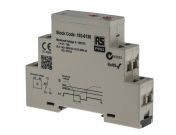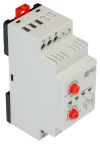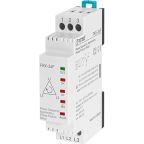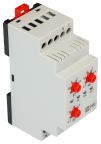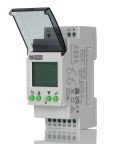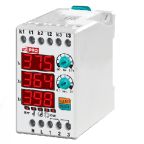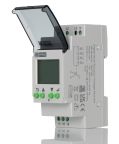Monitoring Relays
Monitoring relays are electrical devices that are used to monitor various parameters in a power system, such as voltage, current, temperature, and frequency, and trigger an alarm or action if the values go beyond a pre-set threshold. They are designed to detect abnormal operating conditions in a system and alert operators or take corrective action to prevent damage to equipment or injury to personnel.
Monitoring relays are commonly used in industrial settings, such as manufacturing plants and data centres, where reliable power is critical. They can also be used in residential or commercial settings to monitor electrical systems and equipment. In addition to monitoring parameters, some monitoring relays also have built-in communication capabilities, allowing them to send alerts or data to a remote monitoring system or operator. This can help operators quickly identify issues and take corrective action, improving system reliability and reducing downtime.
Types of Monitoring Relays
There are many types of monitoring relays, each designed to monitor a specific parameter:
- Voltage Monitoring Relays: a voltage monitoring relay is used to monitor the voltage levels in a circuit and trigger an alarm or action if the voltage levels go beyond a pre-set threshold.
- Current Monitoring Relays: a current monitoring relay is used to monitor the current levels in a circuit and trigger an alarm or action if the current levels go beyond a pre-set threshold.
- Phase Failure Relays: protective devices that detect the loss or imbalance of one or more phases in a three-phase power supply. They help prevent equipment damage by disconnecting loads when phase failure, phase reversal, or undervoltage conditions occur.
- Temperature Monitoring Relays: are protective devices that continuously measure temperature levels in electrical systems or equipment and trigger an alarm or disconnect the circuit if the temperature exceeds a pre-set threshold. They help prevent overheating, ensuring safety and reliability in industrial and automation applications.
Where are Monitoring Relays Used?
Monitoring relays are used in a wide range of applications where it is important to monitor and protect electrical systems and equipment.
- Motor Control: Monitoring relays are commonly used to protect motors from damage caused by overloads, phase loss, or phase imbalance. They can also monitor the temperature of the motor and trigger an alarm or action if it exceeds a pre-set threshold.
- Power Distribution: Monitoring relays are used in power distribution systems to monitor voltage and current levels and trigger alarms or actions if they go beyond a pre-set threshold. This can help prevent damage to equipment and ensure that power is distributed safely and efficiently.
- HVAC: Monitoring relays are used in heating, ventilation, and air conditioning (HVAC) systems to monitor temperature and humidity levels and trigger alarms or actions if they go beyond a pre-set threshold. This can help ensure that HVAC systems are operating efficiently and effectively.
- Lighting: Monitoring relays are used in lighting systems to monitor voltage and current levels and trigger alarms or actions if they go beyond a pre-set threshold. This can help prevent damage to lighting fixtures and ensure that lighting systems are operating safely and efficiently.
- Renewable Energy: Monitoring relays are used in renewable energy systems, such as solar and wind power, to monitor voltage, current, and frequency levels and trigger alarms or actions if they go beyond a pre-set threshold. This can help ensure that renewable energy systems are operating efficiently and effectively.
Whatever the monitoring relays you are looking for, we offer a broad range from the most trusted suppliers worldwide, such as Siemens, Omron, ABB, and our very own RS Pro. Want to learn more about monitoring relays? Read our Electrical Relays Guide to learn more.
Popular Searches
Related links
- RS PRO Phase 3 Phase DIN Rail
- Schneider Electric Phase 3 Phase 380 → 480V ac, DIN Rail
- GIC Phase 3 Phase, DPDT
- Schneider Electric Current 3 Phase, DIN Rail
- Phoenix Contact Voltage Monitoring Relay DPDT, DIN Rail
- Siemens Voltage Monitoring Relay SPDT
- Phoenix Contact Voltage Monitoring Relay, 3 Phase
- Finder Voltage Monitoring Relay SPDT, 300 → 480V ac




